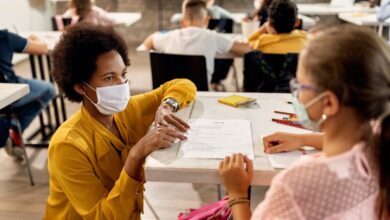
Inclusive education means providing high-quality schooling that’s fair and equitable for all students. It means every child is welcomed and valued without exception.
However, COVID-19 has created, and in some cases exacerbated, educational divides based on postcodes nationwide. Some students in virus-free zones have returned to face-to-face learning, while most Victorian students remain confined to their homes.
Monash researchers have provided some suggested guidance for schools, teachers and parents to help students cope during these challenging times away from the classroom and familiar faces.
While the Victorian Department of Education and schools have moved to address some of these issues – with laptops and dongles provided for students without access to technology – more support is needed, according to Monash University inclusive education researcher and former secondary school teacher Dr Kate de Bruin.
“Inclusive education is a human right, yet many groups of vulnerable students – those who are in unstable or unsafe living arrangements, students with a disability, students who live in remote or regional areas, students who live in poverty, and students from culturally and diverse backgrounds – are disproportionately denied this right,” she said.
“Students living with disabilities have been shown to have reduced access to supports they are normally entitled to, such as attendant care or targeted learning interventions. Parents are reporting targeted funding that schools receive to provide adjustments are not being passed on, and parents have struggled to fill the gaps.”
Monash alumna and inclusive education teacher at Belgrave South Primary School, Suzanne Boatto, understands this challenge in many ways.
A mother of three children, all with additional learning needs, Boatto said taking the principles of inclusive education and extending them to remote learning in the COVID-19 environment was a challenge.
Boatto is part of the whole-of-school vision by Belgrave South to support families during the pandemic. Some of the initiatives the school has implemented include individual therapy and wellness sessions for students, and developing small-group online teaching sessions for literacy and maths to boost inclusive learning across the school community.
“We have all of the learning programs online, and the lessons videoed and aired through YouTube, but it’s the connection that engages the students to learn. We talk about tasks, what each child is finding challenging, and go over misconceptions. Most importantly, we check how they are feeling,” she said.
“Once the learning groups are finished, students have the chance just to chat to each other. This social connection is essential for every child to feel included – they are not alone, and they’re still part of a community that cares.”
Monash Professor of Inclusive Education Umesh Sharma said teaching learners with a range of diversities including disability isn’t easy, as it required teachers to make ongoing adjustments and modifications.
Professor Sharma says there are five simple ways schools and teachers can support students who have additional needs.
Researcher Dr Penny Round has worked with students with special needs for more than 25 years, including time as a teacher and integration leader. She says COVID-19 and the challenges of remote learning are more complex, and add to already onerous teacher workloads.
“However, remote learning means that there are many factors outside a teacher’s control, such as a parent’s ability to monitor their child and facilitate the set activities of the day,” Dr Round said.
“Teachers genuinely want to create a classroom where every child is welcome and has friends and deliver school work that enables children with diverse needs to be independent learners. This involves commitment, planning and a deep knowledge of students.
“Communication with parents is always important to effective inclusion, now more so than ever. Frequent communication is needed with parents who have a child with special needs. Work out a plan that is realistic for both the teacher, parents and the child, and set out the steps to achieve those goals.”







